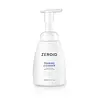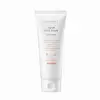What's inside
What's inside
 Key Ingredients
Key Ingredients

 Benefits
Benefits

 Concerns
Concerns

 Ingredients Side-by-side
Ingredients Side-by-side

Water
Skin ConditioningDisodium Lauryl Sulfosuccinate
CleansingSodium Lauroyl Methyl Isethionate
CleansingDisodium Cocoamphodiacetate
CleansingCoco-Glucoside
Cleansing1,2-Hexanediol
Skin ConditioningBetaine
HumectantSodium Chloride
MaskingHydroxyethyl Urea
HumectantCitric Acid
BufferingHydroxyacetophenone
AntioxidantDisodium EDTA
Hexylene Glycol
EmulsifyingSodium PCA
HumectantSodium Hyaluronate
HumectantMyristoyl/Palmitoyl Oxostearamide/Arachamide Mea
Skin ConditioningWater, Disodium Lauryl Sulfosuccinate, Sodium Lauroyl Methyl Isethionate, Disodium Cocoamphodiacetate, Coco-Glucoside, 1,2-Hexanediol, Betaine, Sodium Chloride, Hydroxyethyl Urea, Citric Acid, Hydroxyacetophenone, Disodium EDTA, Hexylene Glycol, Sodium PCA, Sodium Hyaluronate, Myristoyl/Palmitoyl Oxostearamide/Arachamide Mea
Oryza Sativa Extract
AbsorbentGlycerin
HumectantSodium Cocoyl Glycinate
CleansingSorbitol
HumectantWater
Skin ConditioningSodium Lauroyl Glutamate
Disodium Cocoamphodiacetate
Cleansing1,2-Hexanediol
Skin ConditioningCucurbita Pepo Fruit Extract
Skin ConditioningVigna Angularis Seed Extract
Skin ProtectingLauryl Betaine
CleansingOryza Sativa Powder
Sodium Chloride
MaskingHydroxypropyl Starch Phosphate
Acrylates/C10-30 Alkyl Acrylate Crosspolymer
Emulsion StabilisingPolyquaternium-22
Hexylene Glycol
EmulsifyingEthylhexylglycerin
Skin ConditioningHydroxyacetophenone
AntioxidantCitric Acid
BufferingOryza Sativa Extract, Glycerin, Sodium Cocoyl Glycinate, Sorbitol, Water, Sodium Lauroyl Glutamate, Disodium Cocoamphodiacetate, 1,2-Hexanediol, Cucurbita Pepo Fruit Extract, Vigna Angularis Seed Extract, Lauryl Betaine, Oryza Sativa Powder, Sodium Chloride, Hydroxypropyl Starch Phosphate, Acrylates/C10-30 Alkyl Acrylate Crosspolymer, Polyquaternium-22, Hexylene Glycol, Ethylhexylglycerin, Hydroxyacetophenone, Citric Acid
 Reviews
Reviews

Ingredients Explained
These ingredients are found in both products.
Ingredients higher up in an ingredient list are typically present in a larger amount.
1,2-Hexanediol is a synthetic liquid and another multi-functional powerhouse.
It is a:
- Humectant, drawing moisture into the skin
- Emollient, helping to soften skin
- Solvent, dispersing and stabilizing formulas
- Preservative booster, enhancing the antimicrobial activity of other preservatives
Citric Acid is an alpha hydroxy acid (AHA) naturally found in citrus fruits like oranges, lemons, and limes.
Like other AHAs, citric acid can exfoliate skin by breaking down the bonds that hold dead skin cells together. This helps reveal smoother and brighter skin underneath.
However, this exfoliating effect only happens at high concentrations (20%) which can be hard to find in cosmetic products.
Due to this, citric acid is usually included in small amounts as a pH adjuster. This helps keep products slightly more acidic and compatible with skin's natural pH.
In skincare formulas, citric acid can:
While it can provide some skin benefits, research shows lactic acid and glycolic acid are generally more effective and less irritating exfoliants.
Most citric acid used in skincare today is made by fermenting sugars (usually from molasses). This synthetic version is identical to the natural citrus form but easier to stabilize and use in formulations.
Read more about some other popular AHA's here:
Learn more about Citric AcidDisodium Cocoamphodiacetate is a surfactant and helps cleanse skin. It is created from the fatty acids of coconut oil.
Surfactants help rinse oil, dirt, and other pollutants easily from skin. It has a faint fruit-like scent.
Hexylene Glycol is a surfactant. Glycols are a class of alcohols. Hexylene Glycol is a surfactant and emulsifier.
As a surfactant, Hexylene Glycol helps gather dirt and oil on your skin to be washed away.
As an emulsifier, Hexylene Glycol helps keep water and oil together. This prevents them from separating in a product. Hexylene Glycol also thins out the texture of a product by lessening viscosity.
Hexylene Glycol has a small molecular weight.
Learn more about Hexylene GlycolHydroxyacetophenone is antioxidant with skin conditioning and soothing properties. It also boosts the efficiency of preservatives.
This ingredient is not irritating or sensitizing.
Chances are, you eat sodium chloride every day. Sodium Chloride is also known as table salt.
This ingredient has many purposes in skincare: thickener, emulsifier, and exfoliator.
You'll most likely find this ingredient in cleansers where it is used to create a gel-like texture. As an emulsifier, it also prevents ingredients from separating.
There is much debate on whether this ingredient is comedogenic. The short answer - comedogenic ratings don't tell the whole story. Learn more about comegodenic ratings here.
The concensus about this ingredient causing acne seems to be divided. Research is needed to understand if this ingredient does cause acne.
Scrubs may use salt as the primary exfoliating ingredient.
Learn more about Sodium ChlorideWater. It's the most common cosmetic ingredient of all. You'll usually see it at the top of ingredient lists, meaning that it makes up the largest part of the product.
So why is it so popular? Water most often acts as a solvent - this means that it helps dissolve other ingredients into the formulation.
You'll also recognize water as that liquid we all need to stay alive. If you see this, drink a glass of water. Stay hydrated!
Learn more about Water